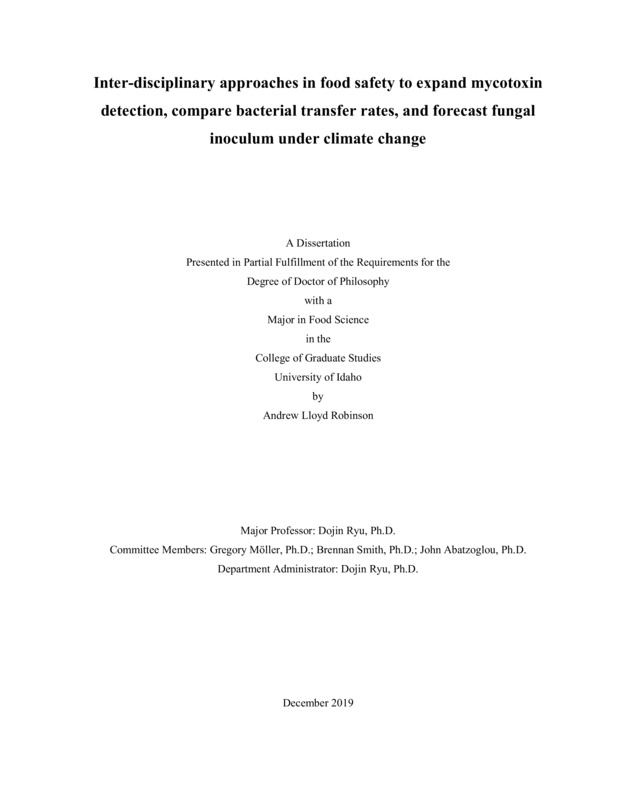Inter-disciplinary approaches in food safety to expand mycotoxin detection, compare bacterial transfer rates, and forecast fungal inoculum under climate change
Robinson, Andrew. (2019-10). Inter-disciplinary approaches in food safety to expand mycotoxin detection, compare bacterial transfer rates, and forecast fungal inoculum under climate change. Theses and Dissertations Collection, University of Idaho Library Digital Collections. https://www.lib.uidaho.edu/digital/etd/items/robinson_idaho_0089e_11709.html
- Title:
- Inter-disciplinary approaches in food safety to expand mycotoxin detection, compare bacterial transfer rates, and forecast fungal inoculum under climate change
- Author:
- Robinson, Andrew
- Date:
- 2019-10
- Program:
- Food Science
- Subject Category:
- Food science; Statistics
- Abstract:
-
Food safety research is complex and interdisciplinary as it involves considerations from pre-production through final home preparation of a food product which passes a long chain of food processing where each stage has potential opportunities for the contamination. The aim of this dissertation was to develop novel methods which could generalize to future food safety issues regarding contamination. This goal was approached by (1) extending a protocol for detection of ochratoxin A into food matrices where phenolic compounds are present, (2) investigation into how bacterial transfer is affected by both hand washing and glove use, (3) interpreting sources of variability in a fungal inoculum source capable of producing deoxynivalenol, and (4) forecasting future shifts in fungal inoculum under climate change.
Ochratoxin A (OTA) is a fungal metabolite and putative carcinogen which can contaminate a variety of foods such as cereals, wine, and nuts. Commercial ELISA kits are known to give false-positive results for OTA concentrations when phenolic compounds are present. Pistachios represent a food matrix rich in phenolic compounds potentially contaminated with OTA, and polyvinylpolypyrrolidone (PVPP) was incorporated during extraction of OTA using a commercial ELISA protocol. HPLC methods were used to confirm that PVPP does not interact with OTA and the cross-reactivity of extracts also decreased with increasing PVPP application.
To assess bacterial transfer from hands to gloves and to compare bacterial transfer rates to food with different soap washing times and glove use, participants’ hands were artificially contaminated with a ~109 CFU inoculum of Enterobacter aerogenes B199A. Different soap rubbing times (0, 3, and 20 s), glove use, and tomato dicing activities were followed. Different soap rubbing times did not significantly change the amount of bacteria recovered from participants’ hands. Both glove use and adequate hand washing are necessary to reduce bacterial cross-contamination as increasing soap washing time decreased the incidence of bacterial contamination recovered from outside glove surfaces (p < 0.05) and dicing tomatoes with bare hands after 20 s of soap rubbing transferred significantly (p < 0.01) less bacteria to tomatoes compared with bare hands after 0 s of soap rubbing.
The plant pathogen Fusarium culmorum represents an inoculum source capable of contaminating grains with deoxynivalenol (DON) in the Inland Northwest (INW) region of the United States. A multilevel modelling approach utilizing varying intercepts for different sampling quadrats, fields, and iterations in the dataset was performed to characterize variability in isolation frequency of F. culmorum collected during a two-year soil survey. Differences in the isolation frequency of F. culmorum varied the most by sampled field followed by quadrat and iteration, respectively. Higher relative elevation within the sampling region of a field limited the amount of F. culmorum recovered.
Isolation records were extended to incorporate the soil dilution factor and used to construct a multilevel climate model. Varying intercepts and slopes were assigned to each unique agricultural field and a weather-based proxy for soil moisture, termed atmospheric water balance (AWB) was used as a predictor variable. Values of AWB derived from downscaled global climate models were used to forecast future shifts in the proportion of F. culmorum across all sampled fields. Population densities of F. culmorum are forecasted to remain constant during the winter and spring but decrease over the summer and fall under climate change, with the magnitude differing across fields.
- Description:
- doctoral, Ph.D., Food Science -- University of Idaho - College of Graduate Studies, 2019-10
- Major Professor:
- Ryu, Dojin
- Committee:
- Moller, Greg ; Smith, Brennan ; Abatzoglou, John
- Defense Date:
- 2019-10
- Identifier:
- Robinson_idaho_0089E_11709
- Type:
- Text
- Format Original:
- Format:
- application/pdf
- Rights:
- In Copyright - Educational Use Permitted. For more information, please contact University of Idaho Library Special Collections and Archives Department at libspec@uidaho.edu.
- Standardized Rights:
- http://rightsstatements.org/vocab/InC-EDU/1.0/

